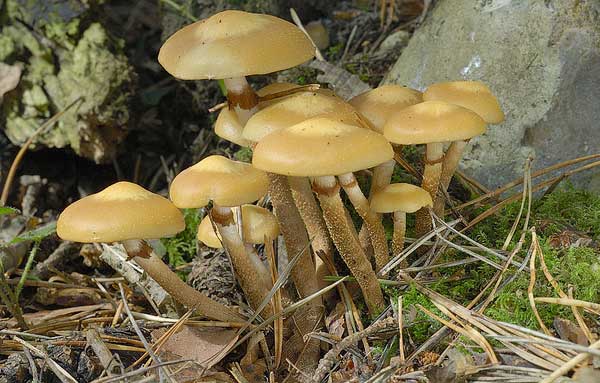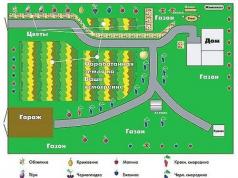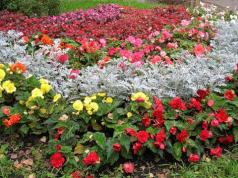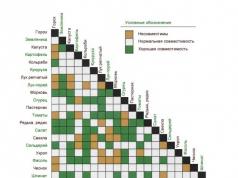Summer honey fungus (Kuehneromyces mutabilis) is an edible mushroom of the agaricomycete class, the stropharia family. Among other names you can find: lime honey fungus, kyuneromyces changeable.
Has the following specific features:
- the cap is smooth, initially convex (hemispherical), then becomes convex-outstretched, with a smoothed obtuse tubercle in the center. The maximum diameter is up to 6 cm. The color is distributed in concentric zones - the protrusion in the center is brownish with a shade of pink, it is surrounded by a creamy yellow area, along the edge there is a darker brownish stripe. The severity of these zones strongly depends on humidity - in dry weather the color fades, after rains the brown tone becomes richer, and the plates shine through the edges of the cap;
- plates are adherent, somewhat descending, relatively rare. Initially light, whitish, as the spores mature, darken to brownish brown;
- spores are brown, dark;
- the leg is brown, fibrous, at first solid, later hollow, cylindrical, narrowing towards the base and darkening. Reaches 8 cm in height and 0.5-1 cm in thickness. There is a well-visible brownish ring on the stem. Above the ring, the surface is lighter, smoother, and below it, it is dark, with scales;
- the flesh is thin, light brown, saturated with moisture in the cap and dryish-fibrous in the stem. Has a pleasant smell of fresh wood.
Spread, harvest season
Summer honey agaric grows in large colonies in the forests of the middle zone, deciduous and mixed. Prefers northern, cool and fairly humid areas. It settles on decaying wood and damaged living trees.

These mushrooms ripen in several waves from May to October inclusive. In some countries, summer mushrooms are cultivated on a scale of the mushroom business.
Similar types and differences from them
Several types of mushrooms are similar to summer honey fungus, bearing fruit simultaneously with it and growing in similar conditions:
- The deadly poisonous fringed gallerina (Galerina marginata), upon a cursory examination, looks like a double of a summer mushroom. However, it can be distinguished by several characteristics. The gallerina has a reddish-buffy cap with a yellowish border along the edge and a fibrous stem without scales with a yellowish ring. The pulp smells like flour. Gallery does not form aggregates. Prefers coniferous forests - on this basis, summer mushrooms are recommended to be collected among deciduous trees.
- The poisonous sulfur-yellow false froth (Hypholoma fasciculare) is colored, in accordance with the name, in sulfur-yellow tones. The top of the cap is reddish-brown, and the sulfur-yellow plates become dark olive with age. There is no ring on the leg.
- Inedible (according to some sources, poisonous) brick-red false froth (Hypholoma sublateritium) has an orange-red color, yellowish bitter flesh and a leg without a ring. The whitish-gray plates eventually turn brown with a yellowish or olive tint.
- The edible gray-lamellar pseudo-froth (Hypholoma capnoides) has a yellowish-brown cap that darkens towards the center and a characteristic color of the plates, which, as the spores mature, turns gray from light steel to brownish.
Primary processing and preparation
Summer honey fungus is certainly edible, belongs to the III-IV category. You can cook it without prior boiling. The collected mushrooms are freed from forest debris, washed well, and then boiled, fried, stewed, pickled and salted. They are also dried - in this case, the mushrooms should not be washed. From well-dried summer honey agarics, you can prepare mushroom powder - a flavoring agent for sauces and soups.
Summer honey mushroom pleases with an early harvest from May-June, abundant growth, tasty preparations under one important condition - the mushroom picker must determine it with absolute reliability, confidently distinguishing it from poisonous false mushrooms and the deadly bordered gallery. To avoid tragic mistakes, it is better to collect this mushroom only if you are fully confident that you have come across it.








